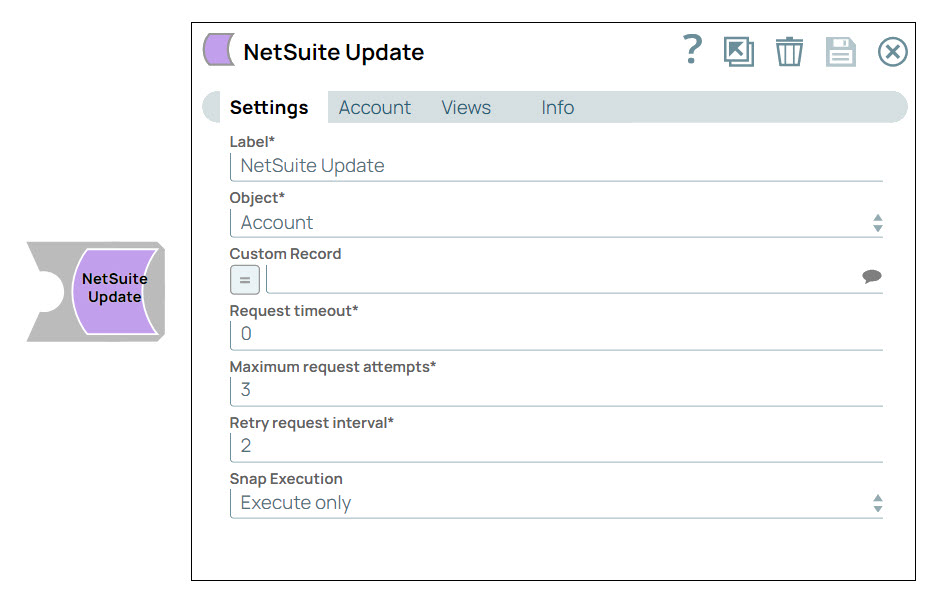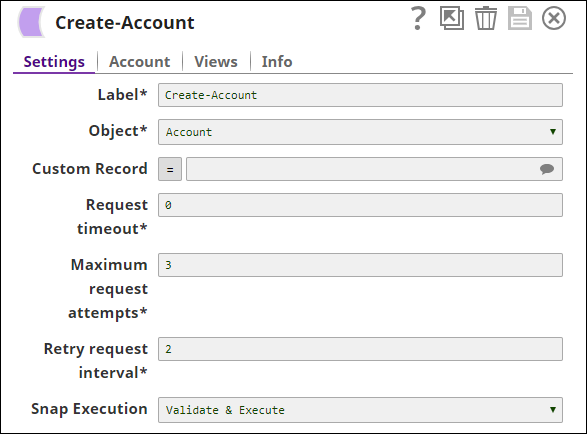On this Page
| Table of Contents | ||||
|---|---|---|---|---|
|
Overview
Snap type: | Write | |||||||||||||
|---|---|---|---|---|---|---|---|---|---|---|---|---|---|---|
Description: | This Snap provides the ability to update records of an object in NetSuite. The fields that can be set on the object are provided on the input view of the Snap and can be mapped using an upstream Mapper or Structure Snap.
| |||||||||||||
| Prerequisites: | [None] | |||||||||||||
| Support and limitations: |
| |||||||||||||
| Account: | This Snap uses account references created on the Accounts page of SnapLogic Manager to handle access to this endpoint. See NetSuite Account for information on setting up this type of account.
| |||||||||||||
| Views: |
| |||||||||||||
Settings | ||||||||||||||
Label | Required. The name for the Snap. You can modify this to be more specific, especially if you have more than one of the same Snap in your pipeline. | |||||||||||||
Object | The NetSuite Object type to update. For example, to search for records of a custom record type, select Custom Record from the available options.
| |||||||||||||
Custom record | Conditional. Custom record type to update. This is applicable and required only if Custom Record is selected for Object. | |||||||||||||
Request timeout | Required. The timeout for the web service call (in seconds). 0 indicates no timeout. Example: 0 | |||||||||||||
Maximum request attempts | Required. Specifies the maximum number of attempts to be made to receive a response. The request is terminated if the attempts do not result in a response. Default value: 3 | |||||||||||||
Retry request interval | Required. Specifies the interval (in seconds) between two successive requests. A retry happens only when the previous attempt resulted in an exception. Default value: 2 | |||||||||||||
|
| |||||||||||||
Troubleshooting
| multiexcerpt-include-macro | ||||||||||
|---|---|---|---|---|---|---|---|---|---|---|
|
Examples
The following example illustrates the usage of NetSuite Update Snap. In this example, using the following pipeline, we update an employee record with the new field values and add a new custom field to it.
| Expand | ||
|---|---|---|
| ||
In the pipeline execution: Mapper (Data) Snap maps the employee data that needs to be updated to the input fields of NetSuite Update Snap: NetSuite Update Snap updates the existing field values for employee records (based on the unique internal ID) and specifies a custom field, custentity7, to be added to the employee record: When the NetSuite Update Snap is saved, it generates the input schema automatically. The following is the data preview of the NetSuite Update Snap: |
Creating and Updating Accounts in NetSuite
In this example, you use the NetSuite Create Snap to create a NetSuite account record, whose schema contains custom fields. You then update the object using the NetSuite Update Snap.
Download this pipeline.
| Expand | ||
|---|---|---|
| ||
You use the Mapper Snap to supply the NetSuite Create Snap with the details needed to create a record: The Mapper Snap provides a document containing the data required to create an account, organized as pairs of key-value attributes: You now run the data through the NetSuite Create Snap, which you configure to create an account: The Snap creates your account using the values you provided through the Mapper Snap, and displays the details associated with the task: You now decide to update the account you just created, and use a Mapper Snap to map attributes in the newly-created account to the new values that you want to assign to them: The Mapper Snap maps the key-value pairs using your inputs, and offers them to the downstream NetSuite Update Snap: Once execution completes, the NetSuite Update Snap updates the account you had created in the previous steps, and displays the results of the operation: |
Downloads
| Multiexcerpt include macro | ||||
|---|---|---|---|---|
|
| Attachments | ||||
|---|---|---|---|---|
|
| Insert excerpt | ||||||
|---|---|---|---|---|---|---|
|



.png?version=1&modificationDate=1490270374079&cacheVersion=1&api=v2)








